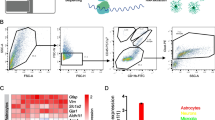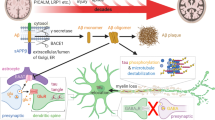Abstract
Chronic cerebral hypoperfusion (CCH) has been proposed to contribute to the progression of memory loss, which is the main symptom of vascular cognitive impairment (VCI). Accumulating evidence indicates that underlying pathophysiology, such as neurodegeneration, may lead to memory loss. However, the underlying molecular basis of memory loss in CCH remains unclear. Here, we investigated the roles of canonical Wnt signaling, which modulates hippocampal function, in a CCH model. CCH was induced by unilateral common carotid artery occlusion (UCCAO). Mice were randomly divided into a sham-operated group or one of three UCCAO groups with different endpoints (1.5, 2.5, and 3.5 months) after UCCAO. Memory function and hippocampal levels of Wnt-related proteins were measured. A Wnt activator, lithium, was administered intraperitoneally to assess memory improvements. In the groups examined 2.5 and 3.5 months after UCCAO, impaired object recognition memory was accompanied by inhibition of Wnt signaling and decreased expression of synaptic/neural activity-related proteins. Recognition memory and Wnt signaling were significantly positive correlated. Moreover, activation of Wnt signaling with lithium significantly attenuated memory loss and recovered synaptic/neural marker expression after UCCAO. Our results suggest that CCH may affect synaptic plasticity via dysregulation of signaling pathways, including canonical Wnt signaling, which could be partly involved in memory loss. As Wnt activator administration alleviated the effects of CCH on memory loss, modulation of Wnt signaling may be a promising therapeutic strategy for VCI.








Similar content being viewed by others
Abbreviations
- αCAMKII:
-
α-Calcium-calmodulin-dependent kinase II
- CA:
-
Cornus ammonis
- CCH:
-
Chronic cerebral hypoperfusion
- DG:
-
Dentate gyrus
- DKK-1:
-
Dickkopf-1
- GLUT:
-
Glucose transporter
- GSK3β:
-
Glycogen synthase kinase 3β
- IEGs:
-
Immediately early genes
- NOR:
-
Novel object recognition
- PSD95:
-
Postsynaptic density-95
- UCCAO:
-
Unilateral common carotid artery occlusion
- VCI:
-
Vascular cognitive impairment
References
Van Der Flier WM, Skoog I, Schneider JA, Pantoni L, Mok V, Chen CL, et al. Vascular cognitive impairment. Nat Rev Dis Primers. 2018;4:18003.
Zhao Y, Gu J-H, Dai C-L, Liu Q, Iqbal K, Liu F, et al. Chronic cerebral hypoperfusion causes decrease of O-GlcNAcylation, hyperphosphorylation of tau and behavioral deficits in mice. Front Aging Neurosci. 2014;6:10.
Zuloaga KL, Zhang W, Yeiser LA, Stewart B, Kukino A, Nie X, et al. Neurobehavioral and imaging correlates of hippocampal atrophy in a mouse model of vascular cognitive impairment. Transl Stroke Res. 2015;6(5):390–8.
Bacigaluppi M, Comi G, Hermann DM. Animal models of ischemic stroke. Part two: modeling cerebral ischemia. Open Neurol J. 2010;4:34.
Zhao Y, Gong C-X. From chronic cerebral hypoperfusion to Alzheimer-like brain pathology and neurodegeneration. Cell Mol Neurobiol. 2015;35(1):101–10.
Liu J, Sun J, Wang F, Yu X, Ling Z, Li H, et al. Neuroprotective effects of Clostridium butyricum against vascular dementia in mice via metabolic butyrate. Biomed Res Int. 2015;2015.
Korczyn AD, Brainin M, Guekht A. Neuroprotection in ischemic stroke: What does the future hold? Taylor & Francis; 2015.
Urushihata T, Takuwa H, Seki C, Tachibana Y, Takahashi M, Kershaw J, et al. Water diffusion in the brain of chronic hypoperfusion model mice: A study considering the effect of blood flow. Magn Reson Med Sci. 2018;17(4):318–24.
Nishino A, Tajima Y, Takuwa H, Masamoto K, Taniguchi J, Wakizaka H, et al. Long-term effects of cerebral hypoperfusion on neural density and function using misery perfusion animal model. Sci Rep. 2016;6:25072.
Guo H, Itoh Y, Toriumi H, Yamada S, Tomita Y, Hoshino H, et al. Capillary remodeling and collateral growth without angiogenesis after unilateral common carotid artery occlusion in mice. Microcirculation. 2011;18(3):221–7.
Ma J, Zhang J, Hou WW, Wu XH, Liao RJ, Chen Y, et al. Early treatment of minocycline alleviates white matter and cognitive impairments after chronic cerebral hypoperfusion. Sci Rep. 2015;5:12079.
Yoshizaki K, Adachi K, Kataoka S, Watanabe A, Tabira T, Takahashi K, et al. Chronic cerebral hypoperfusion induced by right unilateral common carotid artery occlusion causes delayed white matter lesions and cognitive impairment in adult mice. Exp Neurol. 2008;210(2):585–91.
Al-Qazzaz NK, Ali SH, Ahmad SA, Islam S, Mohamad K. Cognitive impairment and memory dysfunction after a stroke diagnosis: A post-stroke memory assessment. Neuropsychiatr Dis Treat. 2014;10:1677.
Finley PR, Warner MD, Peabody CA. Clinical relevance of drug interactions with lithium. Clin Pharmacokinet. 1995;29(3):172–91.
Ciani L, Salinas PC. Signalling in neural development: WNTs in the vertebrate nervous system: From patterning to neuronal connectivity. Nat Rev Neurosci. 2005;6(5):351.
Hall AC, Lucas FR, Salinas PC. Axonal remodeling and synaptic differentiation in the cerebellum is regulated by WNT-7a signaling. Cell. 2000;100(5):525–35.
Fortress AM, Schram SL, Tuscher JJ, Frick KM. Canonical Wnt signaling is necessary for object recognition memory consolidation. J Neurosci. 2013;33(31):12619–26.
Cappuccio I, Calderone A, Busceti CL, Biagioni F, Pontarelli F, Bruno V, et al. Induction of Dickkopf-1, a negative modulator of the Wnt pathway, is required for the development of ischemic neuronal death. J Neurosci. 2005;25(10):2647–57.
Shruster A, Ben-Zur T, Melamed E, Offen D. Wnt signaling enhances neurogenesis and improves neurological function after focal ischemic injury. PLoS One. 2012;7(7):e40843.
Wei ZZ, Zhang JY, Taylor TM, Gu X, Zhao Y, Wei L. Neuroprotective and regenerative roles of intranasal Wnt-3a administration after focal ischemic stroke in mice. J Cerebr Blood F Met. 2018;38(3):404–21.
Wexler E, Geschwind D, Palmer T. Lithium regulates adult hippocampal progenitor development through canonical Wnt pathway activation. Mol Psychiatry. 2008;13(3):285.
Toledo E, Inestrosa N. Activation of Wnt signaling by lithium and rosiglitazone reduced spatial memory impairment and neurodegeneration in brains of an APPswe/PSEN1ΔE9 mouse model of Alzheimer’s disease. Mol Psychiatry. 2010;15(3):272.
Wood AJ, Goodwin GM, Souza RD, Green AR. The pharmacokinetic profile of lithium in rat and mouse; an important factor in psychopharmacological investigation of the drug. Neuropharmacology. 1986;25(11):1285–8.
Shukla V, Fuchs P, Liu A, Cohan CH, Dong C, Wright CB, et al. Recurrent hypoglycemia exacerbates cerebral ischemic damage in diabetic rats via enhanced post-ischemic mitochondrial dysfunction. Transl Stroke Res. 2019;10(1):78–90.
Zhu S, Henninger K, McGrath BC, Cavener DR. PERK regulates working memory and protein synthesis-dependent memory flexibility. PLoS One. 2016;11(9):e0162766.
Kim M-S, Choi B-R, Lee YW, Kim D-H, Han YS, Jeon WK, et al. Chronic cerebral hypoperfusion induces alterations of matrix metalloproteinase-9 and angiopoietin-2 levels in the rat hippocampus. Exp Neurobiol. 2018;27(4):299–308.
Kim M-S, Lee DY, Lee J, Kim HW, Sung SH, Han J-S, et al. Terminalia chebula extract prevents scopolamine-induced amnesia via cholinergic modulation and anti-oxidative effects in mice. BMC Complement Altern Med. 2018;18(1):136.
Kim M-S, Bang JH, Lee J, Han J-S, Baik TG, Jeon WK. Ginkgo biloba L. extract protects against chronic cerebral hypoperfusion by modulating neuroinflammation and the cholinergic system. Phytomedicine. 2016;23(12):1356–64.
Huang J, Guo X, Li W, Zhang H. Activation of Wnt/β-catenin signalling via GSK3 inhibitors direct differentiation of human adipose stem cells into functional hepatocytes. Sci Rep. 2017;7:40716.
Oliva CA, Vargas JY, Inestrosa NC. Wnts in adult brain: from synaptic plasticity to cognitive deficiencies. Front Cell Neurosci. 2013;7:224.
Han P, Ivanovski S, Crawford R, Xiao Y. Activation of the canonical Wnt signaling pathway induces cementum regeneration. J Bone Miner Res. 2015;30(7):1160–74.
Inestrosa NC, Montecinos-Oliva C, Fuenzalida M. Wnt signaling: Role in Alzheimer disease and schizophrenia. J NeuroImmune Pharmacol. 2012;7(4):788–807.
Pimentel-Coelho PM, Michaud J-P, Rivest S. Effects of mild chronic cerebral hypoperfusion and early amyloid pathology on spatial learning and the cellular innate immune response in mice. Neurobiol Aging. 2013;34(3):679–93.
Vannucci SJ, Reinhart R, Maher F, Bondy CA, Lee W-H, Vannucci RC, et al. Alterations in GLUT1 and GLUT3 glucose transporter gene expression following unilateral hypoxia–ischemia in the immature rat brain. Dev Brain Res. 1998;107(2):255–64.
Shah K, DeSilva S, Abbruscato T. The role of glucose transporters in brain disease: Diabetes and Alzheimer’s disease. Int J Mol Sci. 2012;13(10):12629–55.
Li X, Lu F, Wang JZ, Gong CX. Concurrent alterations of O-GlcNAcylation and phosphorylation of tau in mouse brains during fasting. Eur J Neurosci. 2006;23(8):2078–86.
Elizalde N, Gil-Bea FJ, Ramirez MJ, Aisa B, Lasheras B, Del Rio J, et al. Long-lasting behavioral effects and recognition memory deficit induced by chronic mild stress in mice: effect of antidepressant treatment. Psychopharmacology. 2008;199(1):1.
Antunes M, Biala G. The novel object recognition memory: neurobiology, test procedure, and its modifications. Cogn Process. 2012;13(2):93–110.
Plaschke K, Martin E, Bardenheuer H. Effect of propentofylline on hippocampal brain energy state and amyloid precursor protein concentration in a rat model of cerebral hypoperfusion. J Neural Transm. 1998;105(8-9):1065–77.
Cruciat C-M, Niehrs C. Secreted and transmembrane wnt inhibitors and activators. Cold Spring Harb Perspect Biol. 2013;5(3):a015081.
VanGuilder HD, Farley JA, Yan H, Van Kirk CA, Mitschelen M, Sonntag WE, et al. Hippocampal dysregulation of synaptic plasticity-associated proteins with age-related cognitive decline. Neurobiol Dis. 2011;43(1):201–12.
Taft CE, Turrigiano GG. PSD-95 promotes the stabilization of young synaptic contacts. Philos Trans R Soc Lond Ser B Biol Sci. 2013;369(1633):20130134.
Park M, Kim C-H, Jo S, Kim EJ, Rhim H, Lee CJ, et al. Chronic stress alters spatial representation and bursting patterns of place cells in behaving mice. Sci Rep. 2015;5:16235.
Barry DN, Coogan AN, Commins S. The time course of systems consolidation of spatial memory from recent to remote retention: A comparison of the immediate early genes Zif268, c-Fos and Arc. Neurobiol Learn Mem. 2016;128:46–55.
Clark PJ, Bhattacharya TK, Miller DS, Rhodes JS. Induction of c-Fos, Zif268, and Arc from acute bouts of voluntary wheel running in new and pre-existing adult mouse hippocampal granule neurons. Neuroscience. 2011;184:16–27.
Barbosa FF, Santos JR, Meurer YSR, Macêdo PT, Ferreira LMS, Pontes IMO, et al. Differential cortical c-Fos and Zif-268 expression after object and spatial memory processing in a standard or episodic-like object recognition task. Front Behav Neurosci. 2013;7:112.
T O'Brien J, Erkinjuntti T, Reisberg B, Roman G, Sawada T, Pantoni L, et al. Vascular cognitive impairment. Lancet Neurol. 2003;2(2):89–98.
Bhat RV, Budd Haeberlein SL, Avila J. Glycogen synthase kinase 3: A drug target for CNS therapies. J Neurochem. 2004;89(6):1313–7.
Xu J, Culman J, Blume A, Brecht S, Gohlke P. Chronic treatment with a low dose of lithium protects the brain against ischemic injury by reducing apoptotic death. Stroke. 2003;34(5):1287–92.
Funding
This work was financially supported by grants from the National Research Council of Science and Technology (NST) by the Korean government (MSIP) (CRC-15-04-KIST, G17290, G18230, K18850, and KSN1621850).
Author information
Authors and Affiliations
Corresponding author
Ethics declarations
Conflict of Interest
The authors declare that they have no conflict of interest.
Ethical Approval
All experiments were approved by the institutional animal care and use committee of Korea Institute of Science and Technology (Permit number: 2017-103), in concordance with the NIH and ARRIVE guidelines.
Additional information
Publisher’s Note
Springer Nature remains neutral with regard to jurisdictional claims in published maps and institutional affiliations.
Rights and permissions
About this article
Cite this article
Kim, MS., Bang, J. & Jeon, W.K. The Involvement of Canonical Wnt Signaling in Memory Impairment Induced by Chronic Cerebral Hypoperfusion in Mice. Transl. Stroke Res. 11, 734–746 (2020). https://doi.org/10.1007/s12975-019-00748-1
Received:
Revised:
Accepted:
Published:
Issue Date:
DOI: https://doi.org/10.1007/s12975-019-00748-1




